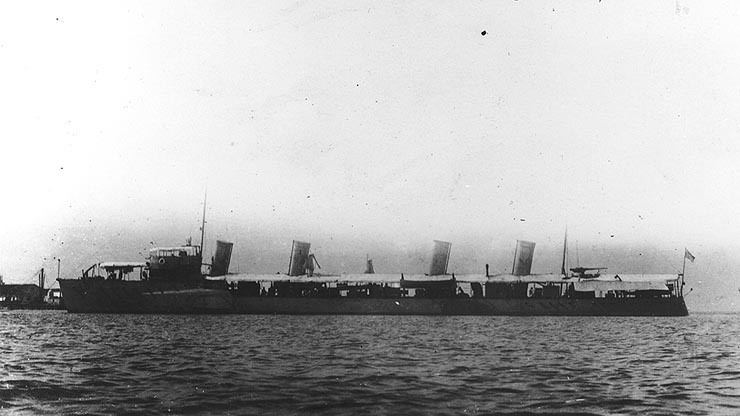Name Bainbridge class Succeeded by Truxtun class | Builders Various Preceded by None | |
 | ||
Subclasses HopkinsLawrencePaul JonesStewart | ||
Officially designated as Torpedo Boat Destroyers (TBDs) when authorized by an Act of Congress on 4 May 1898 under the fiscal year 1899 program, the Bainbridge-class destroyers were the first destroyers so designated of the United States Navy, built from 1899 through 1903. These were the first 13 of 16 TBDs (3 were Truxtun-class TBDs) authorized by Congress in 1898 following the Spanish–American War, and were decommissioned and sold in 1919 following service in World War I. One ship was lost at sea: Chauncey, which collided with the British merchant ship SS Rose in 1917. After decommissioning, the 12 remaining ships were sold to Joseph G. Hitner of Philadelphia, except for Hopkins. Hopkins was sold to the Denton Shore Lumber Company in Tampa, Florida.
Contents
Subclasses
Some sources subdivide the Bainbridge class into additional classes.
Origins
Some references, including contemporary ones, describe four ocean-going torpedo boats launched in 1898-1899 as the first US destroyers based on their tonnage, which ranged from 235 to 340 long tons (239 to 345 t). These were Farragut, Stringham, Goldsborough, and Bailey. Stringham, the largest of these, was larger than some contemporary British destroyers. However, at 420 long tons (430 t) the Bainbridges were considerably larger and had a significantly greater gun armament than the four 6-pounders of the torpedo boats.
The Bainbridge class were produced on the recommendation of an 1898 war plans board formed to prosecute the Spanish–American War and chaired by Assistant Secretary of the Navy Theodore Roosevelt. The poor sea-keeping qualities of existing torpedo boats (such as the 165-long-ton (168 t) Porter) and the existence of Spanish torpedo boat destroyers (such as the 370-long-ton (380 t) Furor) were cited as reasons for the US to build its own destroyers.
Due to construction difficulties the Bainbridges were completed 1901–02, thus too late for the Spanish–American War. However, the destroyer type was instituted in the US Navy, as it had been in the Royal Navy around 1895 with the A-class destroyers. No further torpedo boats were constructed for the US Navy until the outbreak of World War II in Europe, and by then they had no design relationship to destroyers (see PT boats). It should be noted that the Imperial German Navy of 1898–1918 used the term "torpedo boat" for anything up to a large destroyer in size.
Armament
At 420 long tons normal displacement, the Bainbridges were twice as big as most previous torpedo boats. The extra displacement was used for a greatly increased gun armament and a sufficient engineering plant to rival the torpedo boats in speed (28 kn (52 km/h; 32 mph) vs. 29 kn (54 km/h; 33 mph)). The torpedo armament remained at two 18-inch (457 mm) torpedo tubes; although the torpedo boat's mission was being transferred to the destroyer, apparently increased gun armament was more important to the designers than increased torpedo armament.
The gun armament of two 3-inch (76 mm)/50 caliber guns and five 6-pounder (57 mm (2 in)) guns was a great increase over the four 6-pounder guns of the torpedo boat Farragut. It reflected a desire to quickly disable torpedo boats before they could get within range of friendly battleships. Future destroyer classes included progressive increases in armament.
The class was equipped with one or two depth charge racks during World War I for the anti-submarine mission.
Engineering
The best available technologies of coal-fired boilers and triple-expansion engines were used for propulsion, although steam turbines would be adopted in the next generation of US destroyers, beginning with the Smith class launched in 1908. The need for faster destroyers was to be a significant driver of naval propulsion technology throughout the type's future development.
Bainbridge had four Thornycroft boilers supplying 275 psi (1,900 kPa) steam to two triple-expansion engines totaling 7,000 ihp (5,200 kW) (design). She made 28.45 kn (52.69 km/h; 32.74 mph) on trials at 8,000 ihp (6,000 kW). Normal coal capacity was 213 long tons (216 t).
Hopkins also had four Thornycroft boilers supplying steam to two triple-expansion engines totaling 7,000 ihp (design). She made 29.02 kn (53.75 km/h; 33.40 mph) on trials at 8,456 ihp (6,306 kW). Normal coal capacity was lower though, at 150 long tons (150 t).
Lawrence had four Normand boilers supplying steam to two triple-expansion engines totaling 8,400 ihp (6,300 kW) (design). She made 28.41 kn (52.62 km/h; 32.69 mph) on trials 8,400 ihp. Normal coal capacity was even lower, at only 115 long tons (117 t).
An interesting note on destroyers is that they have continuously increased in size since their inception. The Bainbridges were under 650 long tons (660 t) full load; some Arleigh Burke-class destroyers in service in 2013 displace 10,800 long tons (11,000 t) full load, more than the standard displacement limit on 1920s Pensacola class "Treaty cruisers".
Service
A few Bainbridges were deployed to the Philippines 1904-1917. During the US participation in World War I, these were redeployed to the Mediterranean as convoy escorts. Others of the class served in the Atlantic, on the US East Coast, or guarded the Panama Canal. Chauncey collided with the British merchant ship SS Rose in 1917 and was lost. Following the Armistice, the remainder were sold for scrapping or merchant conversion in 1919.
Ships in class
The thirteen ships of the Bainbridge class were:
